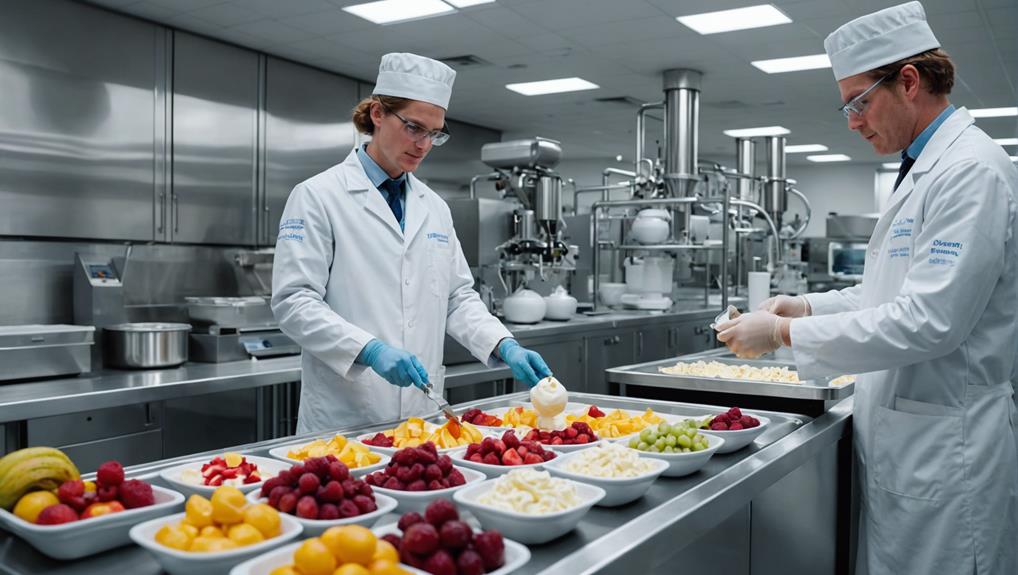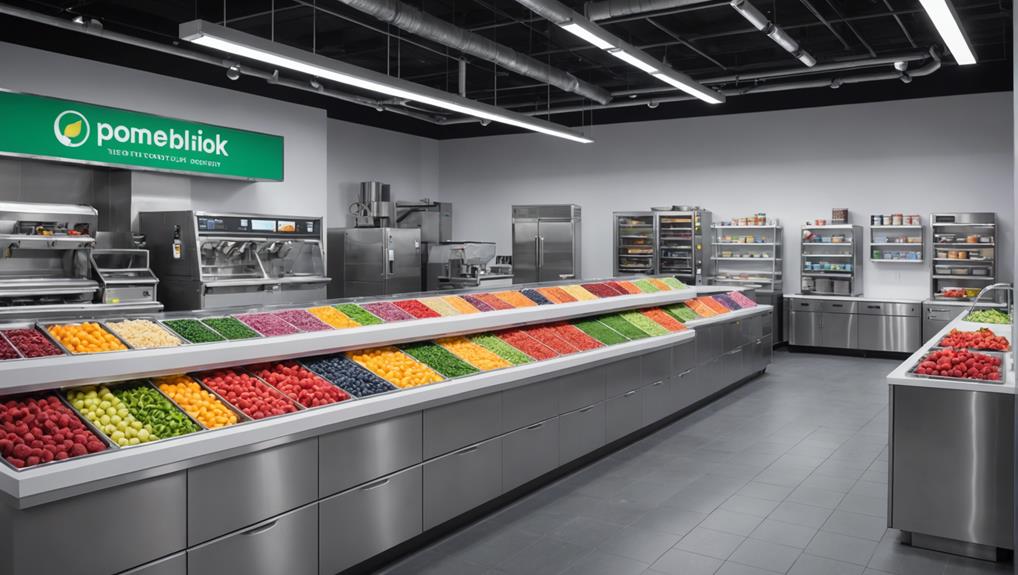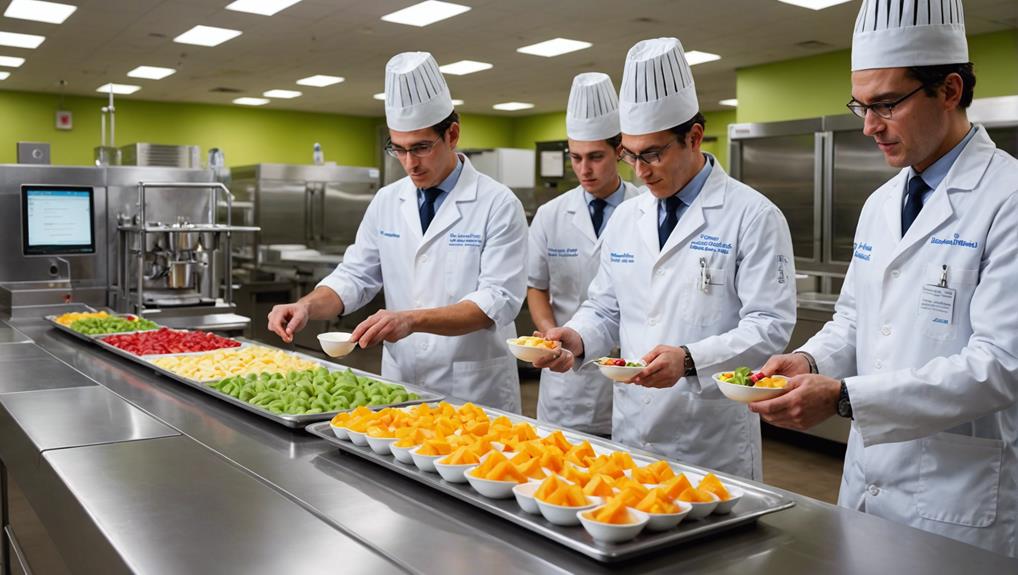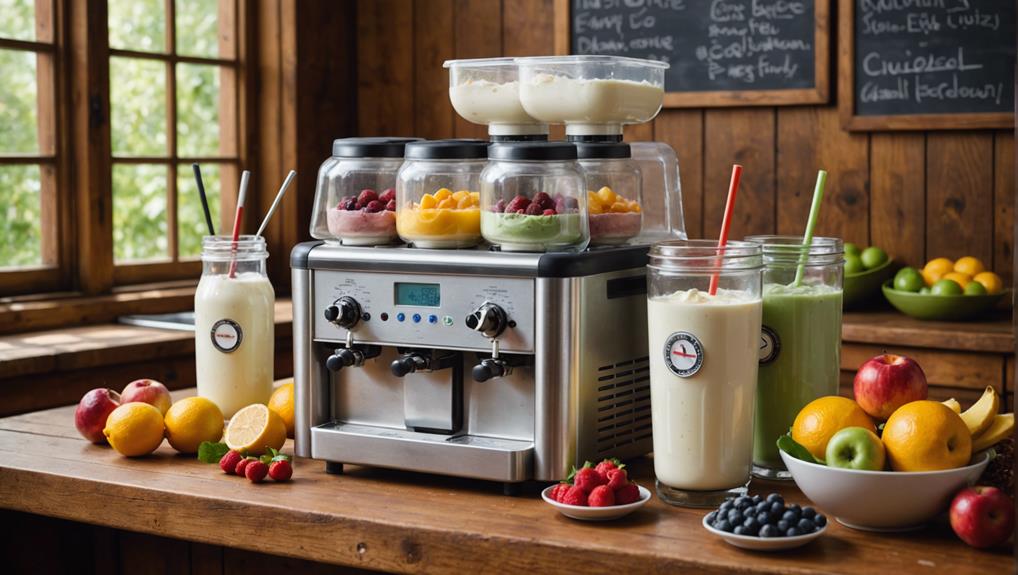Recent innovations in frozen yogurt production have optimized texture and quality through advanced freezing technologies like blast freezing and liquid nitrogen, which minimize ice crystal formation. Plant-based alternatives using almond, coconut, and soy milk cater to vegan and lactose-free consumers. The inclusion of superfoods such as acai and matcha enhances nutritional value. Unique flavor combinations and enhanced texture methods, including the overrun technique and stabilizers, improve consumer appeal. Low-calorie formulations using natural sweeteners align with health-conscious trends. These advancements drive consumer satisfaction and market growth, reflecting a shift towards nutritious and sustainable dietary choices. Discovering more on this topic uncovers deeper industry insights.
Key Takeaways
- Advanced freezing technologies like blast and liquid nitrogen freezing enhance texture and quality by minimizing ice crystal formation.
- Plant-based alternatives using almond, coconut, and soy milk cater to vegan and lactose-free consumers.
- Superfood additions such as acai berries and chia seeds boost the nutritional profile and appeal to health-conscious consumers.
- Unique flavor combinations like activated charcoal and turmeric diversify offerings and intrigue modern palates.
- Texture enhancement methods, including overrun techniques and stabilizers, create a creamier, more consistent product.
Advanced Freezing Technologies

Advanced freezing technologies, such as blast freezing and liquid nitrogen freezing, play a significant role in optimizing the texture and quality of frozen yogurt by minimizing ice crystal formation and preserving live cultures. These rapid freezing methods enable the production of a smoother and creamier product, a critical factor in upholding the high-quality standards expected by consumers. By swiftly lowering the temperature, these technologies effectively reduce the size of ice crystals that form within the frozen yogurt matrix, thereby enhancing its textural properties.
Blast freezing employs high-velocity cold air to rapidly decrease the temperature of the yogurt, while liquid nitrogen freezing uses the extremely low temperatures of liquid nitrogen to achieve similar results. Both methods are instrumental in safeguarding the probiotics and live cultures integral to the health benefits of frozen yogurt. The controlled freezing environments ensure that these beneficial microorganisms remain viable, thereby contributing to the product's nutritional value.
Moreover, the implementation of these advanced freezing technologies not only improves product quality but also enhances production efficiency. This guarantees a consistent and high-quality output, meeting the growing consumer demand for premium frozen yogurt and solidifying the competitive edge of producers in the market.
Plant-Based Alternatives
In addition to utilizing advanced freezing technologies, the frozen yogurt industry is increasingly incorporating plant-based alternatives to meet the rising consumer demand for dairy-free and vegan options. These alternatives typically employ bases such as almond milk, coconut milk, and soy milk, which offer a creamy texture analogous to traditional dairy products. The shift towards plant-based frozen yogurt allows producers to cater to a growing demographic seeking vegan-friendly and lactose-free dessert choices.
Analytically, the market for plant-based frozen yogurt is poised for significant growth. This trend is driven by heightened consumer awareness surrounding health and sustainability. Consumers are increasingly inclined towards dairy-free options due to lactose intolerance concerns and the environmental impact associated with dairy farming. Plant-based alternatives are thus an attractive proposition for both health-conscious and environmentally conscious consumers.
Moreover, the technical formulation of plant-based frozen yogurt involves careful selection of ingredients to ensure textural and flavor profiles that satisfy consumer expectations. The incorporation of these dairy-free options not only diversifies product offerings but also aligns with broader trends in the food industry towards more inclusive and sustainable dietary choices. Consequently, the innovation in plant-based frozen yogurt production underscores a pivotal shift in consumer preferences and industry practices.
Superfood Additions

Incorporating superfoods such as acai berries, chia seeds, and matcha powder into frozen yogurt production greatly enhances its nutritional profile, appealing to the health-conscious consumer seeking added wellness benefits. These superfood additions are rich in antioxidants, vitamins, and minerals, which greatly contribute to the holistic health benefits of frozen yogurt. Acai berries, for instance, are known for their high antioxidant content, aiding in the reduction of oxidative stress. Chia seeds offer substantial amounts of omega-3 fatty acids and fiber, promoting cardiovascular health and digestive regularity. Matcha powder provides a concentrated source of catechins, which have been linked to improved metabolic rates and cognitive functions.
The incorporation of these superfoods not only elevates the nutritional value but also enhances the taste, texture, and visual appeal of frozen yogurt. This aligns well with the current market trend where health-conscious consumers are increasingly gravitating towards innovative dessert options that offer guilt-free indulgence. By integrating superfood additions, producers can meet the demand for nutritious yet delicious alternatives, thereby fostering consumer loyalty and expanding market share in the competitive landscape of frozen desserts. This strategy underscores the intersection of health benefits and consumer preferences, driving innovation in frozen yogurt production.
Unique Flavor Combinations
Exploring a myriad of unique flavor combinations, frozen yogurt producers are leveraging ingredients such as activated charcoal, turmeric, and tahini to craft distinct and innovative taste profiles. The industry has evolved greatly, incorporating unconventional pairings like mango chili, blueberry basil, and strawberry balsamic to meet the adventurous palates of today's consumers.
The following table showcases some of the innovative flavor combinations that are currently trending in the frozen yogurt market:
| Flavor Combination | Key Ingredients |
|---|---|
| Matcha Green Tea | Matcha, Milk |
| Salted Caramel | Caramel, Sea Salt |
| Honey Lavender | Honey, Lavender Extract |
| Coconut Curry | Coconut, Curry Powder |
| Rosewater Pistachio | Rosewater, Pistachio |
These unique flavor combinations not only diversify the product offerings but also enhance consumer experiences by providing distinctive taste profiles. For instance, coconut curry offers a savory twist, while rosewater pistachio provides a floral and nutty delight. Brands are also experimenting with superfoods and spices such as cardamom rose, ginger lemon, and pomegranate mint, further illustrating the industry's commitment to innovation.
Through technical advancements and a deep understanding of consumer preferences, frozen yogurt producers are successfully creating flavors that not only satisfy but also intrigue the modern-day palate, ensuring a competitive edge in the market.
Texture Enhancement Methods

Building upon the innovative flavor combinations, mastering texture enhancement methods is equally important in delivering a superior frozen yogurt experience. One of the primary innovations in frozen yogurt texture enhancement is the incorporation of air during the freezing process. This technique, known as overrun, is essential in achieving a creamier and smoother consistency. High-speed blending techniques further enhance this by improving the overall mouthfeel, thereby guaranteeing a high-quality product.
Stabilizers such as guar gum and carrageenan play a pivotal role in maintaining the desired consistency and preventing ice crystal formation. Their usage ensures the frozen yogurt retains its smooth texture even during storage. Additionally, emulsifiers like lecithin contribute significantly to achieving a silkier and more uniform texture by promoting better fat dispersion throughout the product.
Proper temperature control during production is another critical factor in texture enhancement. Maintaining ideal temperatures ensures that the frozen yogurt develops a velvety and luscious texture, which is essential for consumer satisfaction. These innovations in frozen yogurt production highlight the importance of texture enhancement methods in creating a product that is not only flavorful but also texturally superior.
Probiotic Benefits
Furthermore, the integration of live probiotic cultures in frozen yogurt has shown significant potential for enhancing gut health, as evidenced by improved digestion efficiency and nutrient absorption. Specific probiotic strains, when included in the production process, have been linked to boosting the immune system by modulating the gut microbiota. Additionally, these probiotic benefits cater to the increasing demand for functional foods that contribute to overall well-being.
Enhancing Gut Health
Incorporating live active cultures in frozen yogurt production is a scientifically proven method to enhance gut health and improve digestive functions. Probiotics, which are beneficial bacteria, play a key role in maintaining a balanced gut microbiota. The inclusion of these live active cultures in frozen yogurt can greatly contribute to the proliferation of healthy gut flora, thereby promoting excellent digestive health. Studies have shown that the consumption of probiotic-rich frozen yogurt can alleviate gastrointestinal disturbances such as bloating, constipation, and diarrhea.
The National Yogurt Association certifies frozen yogurt brands that contain specific strains of probiotics, ensuring that consumers receive maximum health benefits. These strains, often including Lactobacillus and Bifidobacterium, are well-documented for their capacity to survive the digestive process and colonize the gut effectively. This certification is essential for both consumer trust and the functional efficacy of the product.
Furthermore, the increasing consumer demand for functional foods has driven innovation in frozen yogurt production, leading to formulations that not only satisfy taste preferences but also deliver health benefits. Regular intake of probiotic-enhanced frozen yogurt aligns with dietary strategies aimed at improving gut health and overall well-being, making it a valuable addition to modern diets.
Boosting Immune System
While the primary focus of probiotics in frozen yogurt has traditionally been on gut health, emerging research indicates that these beneficial bacteria also play a significant role in enhancing the immune system. Probiotics in frozen yogurt, such as Lactobacillus and Bifidobacterium strains, have demonstrated potential in modulating the immune response, thereby enhancing the body's ability to combat infections. These live cultures interact with the gut-associated lymphoid tissue (GALT), which plays a critical role in the immune system's functionality.
The regular consumption of frozen yogurt enriched with probiotics can lead to the maintenance of a balanced gut microbiota, which is integral to a well-functioning immune system. Studies have shown that probiotics can increase the production of immunoglobulins, particularly IgA, which serve as the first line of defense against harmful pathogens. Additionally, the anti-inflammatory properties of certain probiotic strains contribute to reducing systemic inflammation, further supporting immune health.
Incorporating frozen yogurt with probiotics into one's diet may hence provide an effective, delicious, and accessible means to bolster immune defenses. By maintaining a robust immune system, individuals can potentially reduce the frequency and severity of infections, thereby enhancing overall health and well-being.
Improving Digestion Efficiency
Many studies have demonstrated that the live probiotic cultures present in frozen yogurt greatly enhance digestion efficiency by promoting a balanced gut microbiome. These probiotic cultures are instrumental in fostering improved digestive health by maintaining an ideal balance of beneficial bacteria in the gastrointestinal tract. Such a balanced gut flora is essential for the efficient breakdown and assimilation of nutrients, thereby facilitating enhanced nutrient absorption.
Moreover, the regular consumption of frozen yogurt enriched with probiotics can mitigate common digestive issues, including bloating and gas. The presence of live cultures in frozen yogurt aids in the fermentation process, breaking down lactose and other complex molecules that can otherwise cause discomfort. This not only alleviates gastrointestinal distress but also optimizes the process of nutrient extraction from ingested food.
Furthermore, probiotics in frozen yogurt have been linked to bolstering the body's immune system, which is intricately connected to gut health. A robust gut microbiome acts as a first line of defense against pathogenic bacteria and viruses, thereby supporting overall well-being. Consequently, the integration of probiotic-rich frozen yogurt into the diet serves as a multifaceted approach to enhancing digestive health and nutrient absorption efficiency.
Low-Calorie Formulations

Low-calorie formulations in frozen yogurt, characterized by reduced sugar, fat, and calorie content, are increasingly favored by health-conscious consumers seeking nutritious dessert alternatives. This trend reflects a broader shift towards healthier eating habits, driven by growing awareness of diet-related health issues. These formulations typically utilize natural sweeteners such as stevia and monk fruit, which provide the desired sweetness without adding significant calories. The reduction in sugar content not only helps in lowering the overall caloric value but also aligns with dietary guidelines recommending reduced sugar intake.
Moreover, the incorporation of added protein, probiotics, and fiber enhances the nutritional profile of low-calorie frozen yogurt. Protein fortification supports muscle maintenance and repair, while probiotics contribute to gut health, potentially improving digestion and immunity. Fiber, on the other hand, aids in satiety and digestive health, making these formulations more appealing to consumers seeking functional foods.
The development of low-calorie frozen yogurt aligns with market demands for healthier dessert options, offering a competitive edge to manufacturers. By balancing taste and nutritional benefits, these innovations cater to a growing segment of health-conscious consumers, ensuring sustained interest and consumption in the market.
Consumer Trends
Building on the advancements in low-calorie formulations, consumer trends in frozen yogurt emphasize a growing preference for customizable, nutritious options that align with health and sustainability values. The modern consumer increasingly seeks low-calorie and high-protein alternatives, viewing frozen yogurt as a healthier dessert compared to traditional ice cream. This shift in preference is supported by a rising demand for probiotic-rich offerings, further reinforcing frozen yogurt's position as a functional food.
Customization plays a significant role in enhancing consumer satisfaction, with a wide array of flavors and toppings allowing for personalized experiences. This trend not only meets individual dietary requirements but also caters to diverse taste preferences, making frozen yogurt an attractive option for a broad demographic.
Sustainability is another critical factor driving consumer trends. Eco-friendly packaging and the use of organic ingredients resonate well with environmentally conscious consumers. Brands that adopt sustainable practices are likely to gain a competitive edge in the market.
Moreover, the global expansion of the frozen yogurt market, particularly in emerging regions like Asia-Pacific and Latin America, underscores the growing acceptance and demand for these health-oriented, customizable products. This trend reflects a broader global shift towards health-conscious and environmentally sustainable dietary choices.
Frequently Asked Questions
What Is the Technology of Yogurt Production?
Yogurt production technology involves pasteurization techniques to guarantee safety, the addition of bacterial cultures for fermentation process initiation, and advanced equipment to maintain ideal conditions, ensuring consistency and quality control throughout the manufacturing cycle.
What Is Unique About Frozen Yogurt?
Frozen yogurt is unique for its health benefits from live active cultures, diverse flavor profiles, and rich cultural origins. It offers a tangy, creamy texture with lower fat content, appealing to health-conscious consumers and providing a customizable dessert experience.
How Can You Improve the Texture of Frozen Yogurt?
Improving the texture of frozen yogurt can be achieved by optimizing fat content, utilizing stabilizing agents like guar gum and xanthan gum, and refining freezing techniques to enhance creaminess and prevent ice crystal formation.
Can You Make Money With a Frozen Yogurt Business?
Indeed, profitability in a frozen yogurt business is achievable with strategic marketing strategies targeting diverse customer demographics and capitalizing on seasonal trends, as evidenced by the market's projected compound annual growth rate and expanding global opportunities.
Conclusion
Innovations in frozen yogurt production have greatly transformed the industry, with advancements such as plant-based alternatives and superfood additions. Importantly, the global frozen yogurt market is anticipated to reach $2.1 billion by 2026, driven by increasing consumer demand for low-calorie formulations and probiotic benefits. Enhanced texture methods and unique flavor combinations also play vital roles. These developments align with evolving consumer trends, underscoring the sector's dynamic growth and potential. The continuous evolution denotes a promising future for frozen yogurt.







